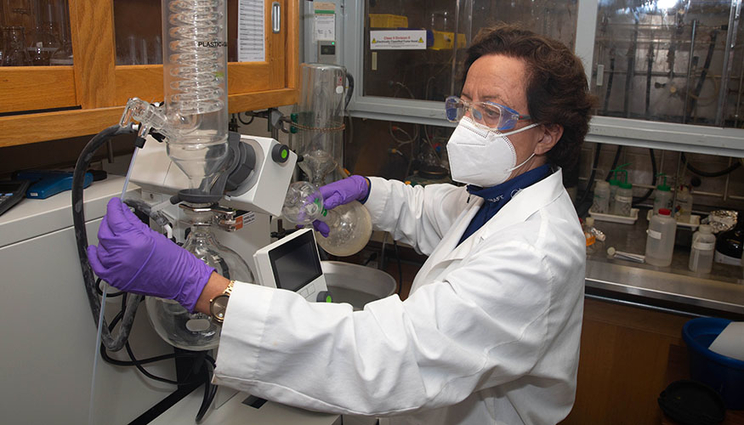Playing it safe: LLNL scientist creates energetic compounds with isotopic labels
 (Download Image)
(Download Image)
Ana Racoveanu synthesizes energetic compounds with isotopic labels to help make munitions safe to handle and use. Photo by Julie Russell/LLNL.
Ana Racoveanu is able to do something most others throughout the nuclear security enterprise cannot do — something challenging and extremely valuable throughout the complex.
Racoveanu, a staff scientist in Lawrence Livermore National Laboratory’s Materials Science Division, is able to synthesize energetic compounds with isotopic labels.
The primary goal of this work is to make munitions safe to handle and use. Isotopic labeling is when a specific type of atom, such as a nitrogen, is replaced with a nitrogen of a different isotope. Successful synthesis of labeled energetic materials facilitates the understanding of the fundamental science of explosives.
“This work unlocks a unique method of examining the science of energetic materials,” Racoveanu said. “It is a tracer method allowing discovery of reaction networks of energetic materials during performance as well as in environments not encountered during normal operations or abnormal environments.”
The work addresses issues of energetics exposed to abnormal environments, something the National Nuclear Security Administration is interested in because it leads to making the nuclear deterrent safer, longer-lasting and easier to maintain.
Racoveanu explains that, in general, materials labeled with stable isotopes (2H, 15N, 13C, and 18O) provide a new and safe way to gain insight into the behavior of these materials in various chemical and biochemical systems. The study of energetic compounds labeled with stable isotopes reveals scientific facts that aid in understanding the sensitivity to stimuli of these materials, as well as reaction pathways.
Challenge of labeling energetics is now a thing of the past
A few stable isotopically labeled energetics have been made in the past and the main constraint in extensive labeling of energetic materials has been the very high cost of starting materials. Nowadays, the less costly labeled ingredients, along with the increase in number of available synthetic methods for energetics, make the isotopic labeling more accessible. Still, these efforts are limited to small quantities because of expense, Racoveanu said.
“The main challenge in stable isotopic labeling in general is the very skillful execution of synthesis of all the steps involved,” Racoveanu said. “Failure during the synthetic process is solvable, but at a very high cost, sometimes unaffordable. This is valid for the synthesis of isotopically labeled energetic materials, as well. Also, designing alternate pathways for making the labeled endpoints may have to be done because the appropriate labeled starting material is not available.”
The isotopic labeling is conducted in one or multiple synthetic steps, depending on the desired position of the label. Each step involves reacting isotopically labeled components, isolating the crude product followed by purifying. The final targeted material is then analyzed for chemical purity and isotopic purity.
Sandia National Laboratories recently reached out to Racoveanu to help label a variety of high explosives (fully 15N labeled CL-20 and fully labeled 13C HNS). LLNL will continue the work of labeling the following high explosives: tri-amino-tri-nitrobenzene (TATB) with 13C and 18O; CL-20 with 15N, 13C and 2H.
'Results have taken us places we have never gone before'
Racoveanu has been making isotopically labeled compounds for a project Lab scientist John Reynolds has been working on.
“To paraphrase 'Star Trek,'” Reynolds said, “Ana has made several labeled compounds for my project and the results have taken us places we have never gone before. As her success has become more and more obvious, some other scientists have approached her to make isotopically labeled materials for their projects.”
Reynolds said this work not only highlights the talents of one LLNL scientist, but also shows the establishment of a very successful operation in making isotopically labeled energetics, something not accomplished until Racoveanu’s efforts.
Racoveanu acknowledges several colleagues as key experimental contributors to the success of this work, including Nathaniel Zuckerman, Phil Pagoria, Keith Coffee, Ryan Kelley and Larry Peck. Alan DeHope was the initiator of Racoveanu’s involvement in isotopic labeling, Evan Kahl guided initial funding, Reynolds guided the effort towards TATB and Rick Gee, Will Shaw and Jonathan Crowhurst made the CL-20 work possible.
Contact
 Michael Padilla
Michael Padilla
[email protected]
(925) 341-8692
Related Links
WCITags
HEAFEnergetic Materials Center
Advanced Materials and Manufacturing
Materials Science
Global Security
Physical and Life Sciences
Science
Featured Articles







